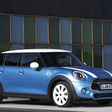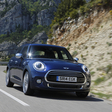You can login to your account or create a new account.
You can login to your account or create a new account.
You can login to your account or create a new account.
Mini launched its third generation Mini on the 107th birthday of Alec Issigonis, the designer of the original Mini. The third generation rides on BMW’s brand new UKL platform for front-wheel drive cars and uses a new modular engine family.
The exterior design is a mild update over the second generation but many buyers may not be able to tell the new car from the old one. The biggest change comes at the front. The front grill is split between chrome strips at the top and a gloss black bumper below. The Cooper S replaces the chrome with a mesh design. It also gets new LED running lights in a ring around headlights. Compared to the previous two generations of the modern Mini, the hood is far flatter and higher to meet pedestrian safety rules.
The rear is also quite similar to the previous generation. The headlights have grown significantly and now cut into the hatchback. Like the previous two generations, the Cooper has a single exhaust at the side of the car, and the Cooper S gets dual center exhausts with a simulated diffuser. From the side, the latest generation is nearly identical as the previous generations, except for slightly larger rear wheel arches.
Compared to the previous generation, the third generation Mini is 98mm (3.9in) longer, 44mm (1.7) wider and 7mm (0.28in) higher. The wheelbase is 28mm (1.1in) longer, and the track is 42mm (1.7in) wider in the front and 34mm (1.3in) wider in the rear. The changes make the rear seat 23mm (0.9in) wider, and the luggage compartment is 51 liters (1.8 cubic feet) larger.
All models use turbocharged engines. The Mini Cooper comes with a three-cylinder 1.5-liter engine with 134hp (136ps) and 162lb-ft (220Nm) or 170lb-ft (230Nm) with boost. It takes 7.9 seconds to reach 100km/h or 7.8 seconds with the automatic. The Cooper S uses a 2.0-liter four-cylinder turbocharged engine with 189hp (192ps) and 207lb-ft (280Nm) or 221lb-ft (300Nm) with overboost. It takes 6.8 seconds to reach 100km/h or 6.7 seconds with the manual. The Cooper D used a 1.5-liter three-cylinder diesel with 114hp (116ps) and 199lb-ft (270Nm). It reaches 100km/h in 9.2 seconds with either transmission.
All of them come with a six-speed manual transmission or an optional six-speed automatic transmission, and stop/start is also standard.
The new platform also gives the car a new suspension layout. Up front, it has a single-joint spring strut axle made from aluminum and steel components. The rear gets a new multilink rear suspension. A new electronically controlled differential is also standard. There are three throttle and steering modes – Mid, Sport and Green – that tune the car to the driver’s demands. The Mini Cooper S has a three-setting active suspension system.
Inside, the Mini no longer has a center-mounted instrument panel. The speedometer and tachometer are attached to the steering wheel, and the previous location is used for infotainment and the optional backup camera. There is also an optional head-up display.
In 2014 MINI unveiled a five-door MINI hatchback. It is larger and more spacious, but doesn't runaway from the brand's standards.
The five-door MINI is larger and more spacious than the three-door version. With around 4m in length, varying with the version, the five-door MINI hatchback has a wheelbase 72 mm longer than the three-door model and is 161 mm longer overall. The increase of the wheelbase is reflected in the increase of the rear area of the cabin.
The cargo area has also become more competitive with an increase to 278 liters, 67 liters more than the three-door version. With the rear seats folded the maximum load capacity of the MINI increases to 941 liters.
At launch the five-door MINI is available in Cooper version, with a three-cylinder engine gasoline, the Cooper D version, with the three-cylinder diesel engine, and the Cooper S and Cooper SD version, with four-cylinder petrol and diesel engines respectively. All versions are equipped as standard with a manual six-speed gearbox, but all of them can be combined optionally with a Steptronic six-speed automatic transmission.
In a combination of performance and efficiency, the power of the engine range of the five-door MINI hatchback starts with the 116hp of the Cooper D and goes up to 196hp of the Cooper S, while consumption varies between 3.8 and 5.9l/100km. All versions meet EU6 emissions standards.
In terms of looks the big difference between the three and five-door variants is the introduction of additional doors. The rest of the design remains true to the third generation MINI.
MINI (BMW)
The development of the brand new MINI had been under operations since 1995, under the management of the – then parent company – Rover Group. BMW took over the job in 1999 and kept on developing it until 2001. The German company presented the refreshed brand for the first time at the 2000 Paris Auto Show, with a MINI concept car version.
Operations on the brand’s fresh new line-up began and still remain wher... more








